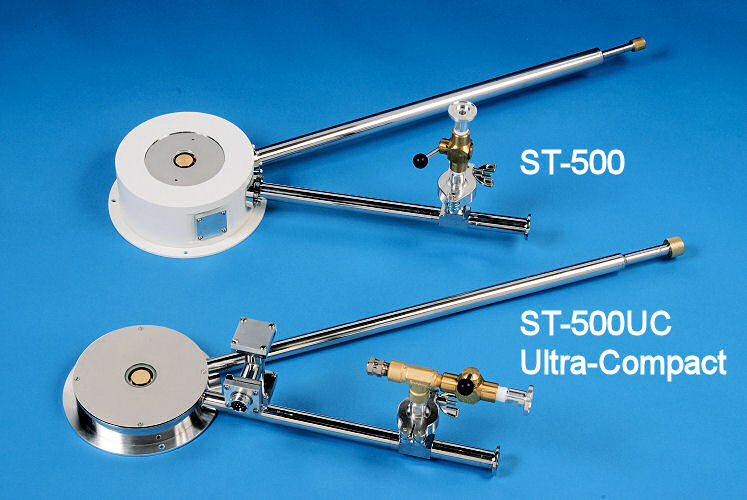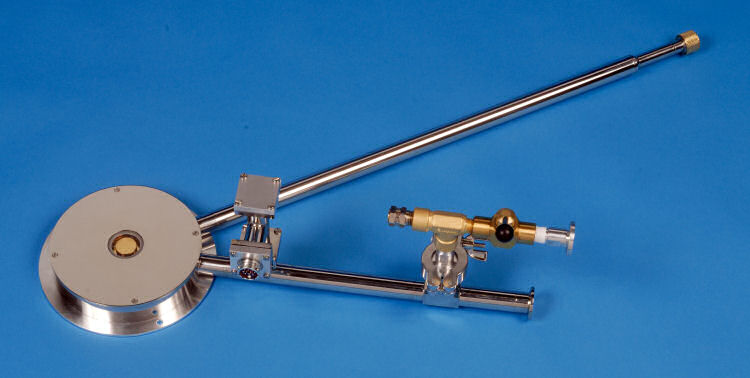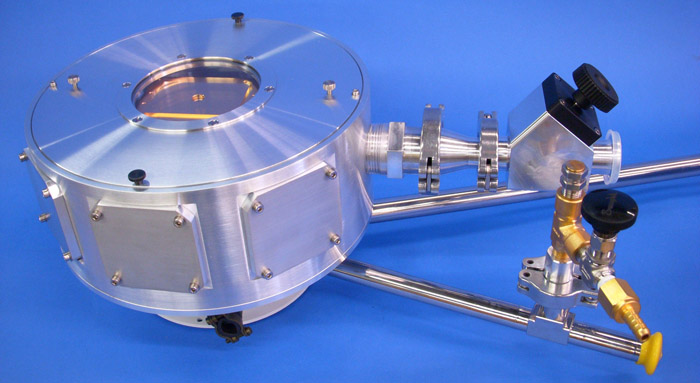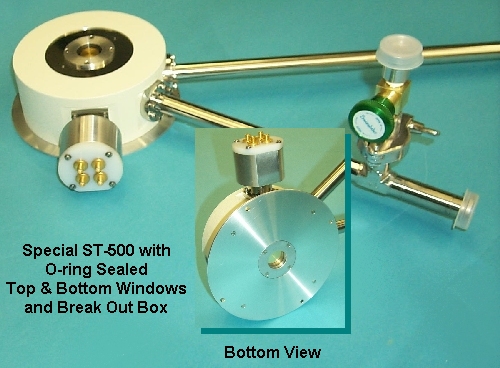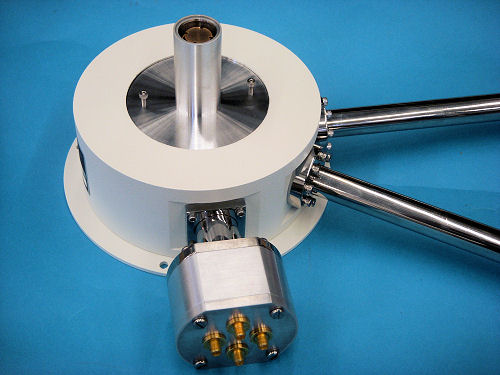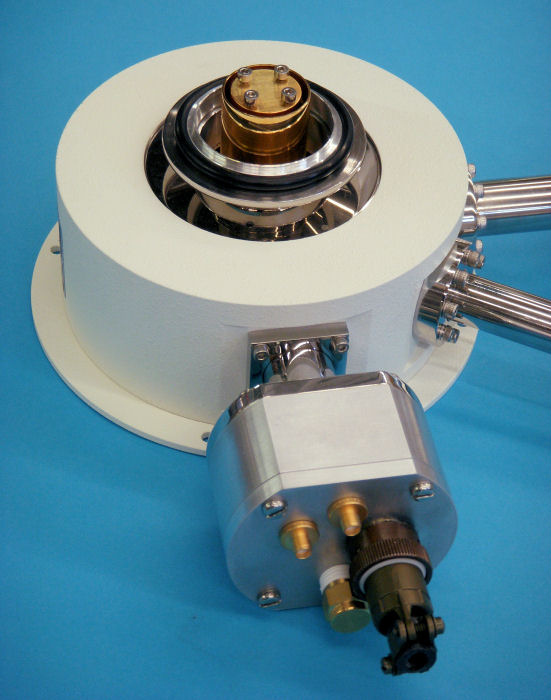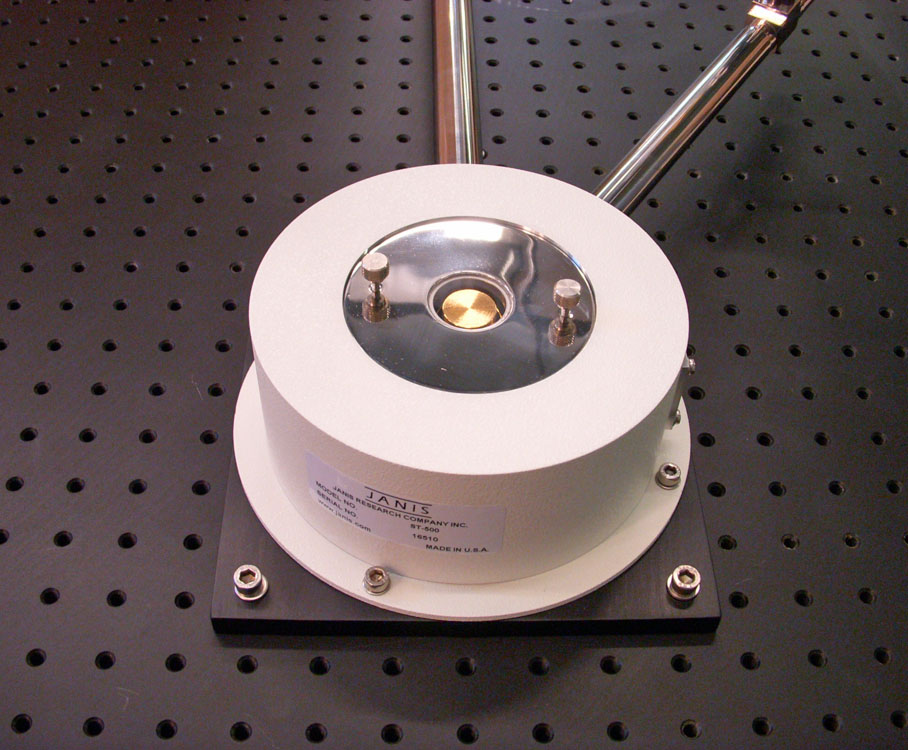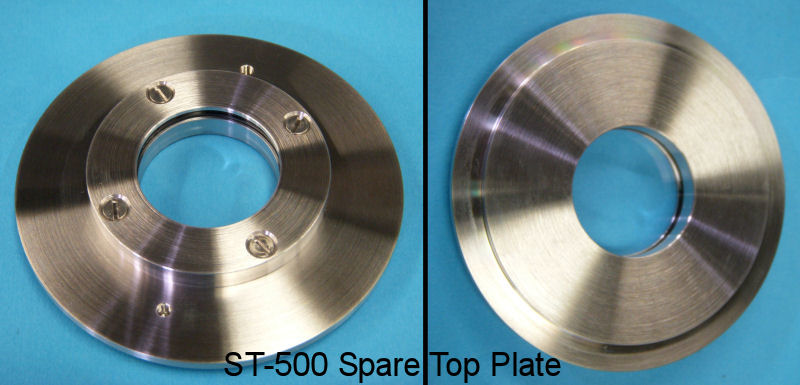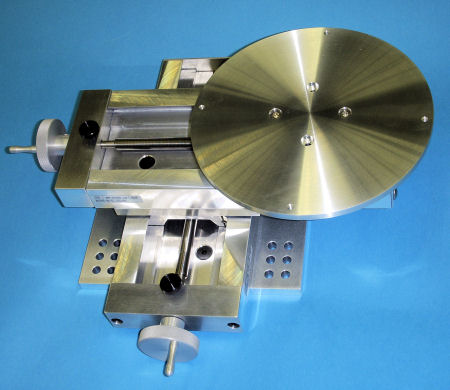ST-500 Microscopy Cryostat
The Janis ST-500 continuous flow cryostat has been specially designed for use in microscopy, imaging, and high spatial resolution photoluminescence. The combination of the low thermal-expansion support structure and internal vibration isolation results in nanometer-scale vibration and drift levels. The cryostat geometry offers a short working distance (for use with high magnification optics) and permits mounting on common microscope stages and translators.
Standard configuration
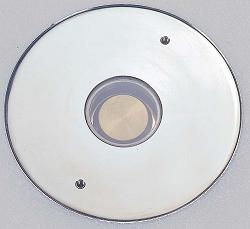
The ST-500 system includes a flexible high-efficiency variable flow cryogen transfer line. This line delivers liquid helium or liquid nitrogen to a two-stage heat exchanger and sample mount. The ST-500 is portable, easily mounted in a variety of configurations, and can be used both in transmission and reflection geometries.
Other configurations include:
- Ultra-compact
- Options for micro-spectroscopy techniques
- Nano-positioning stages from attocube
- Sample extension for magnetic measurements
- Breakout box accessory for electrical measurements
- Ultra-high vacuum
- Superconducting magnet for high-resolution microscopy
- Micro-manipulated cryogenic and vacuum probe system for chips, wafers, and device testing

Options include:
- A variety of window materials and sizes
- Interchangeable sample mounts for different sample thicknesses
- Magneto-optical system (including optional rare earth magnets)
- Electrical and RF feedthroughs
- A complete system solution including temperature controllers, pumping systems, and storage Dewars
- Looking for a cryogen-free option for your existing ST-500? Optional recirculating gas cooler eliminates the use of liquid helium for "wet" systems.
Contact us today!


ST-500 Specifications
| Temperature range | 3.5 to 475 K (standard) |
| Initial cooldown time | 10 K (LHe): 25 min |
| 80 K (LN2): 30 min | |
| Cryogen usage during cooldown to 4.2 K | 1 L LHe |
| 0.3 L LN2 | |
| Temperature stability (with temperature controller) | <50 mK |
| Weight (not including transfer line) | 7 lb (3.2 kg) |
| Nominal cryogen usage | LHe at 5 K: ~1.1 L/h |
| LN2 at 80 K: ~0.1 L/h | |
| Nominal vibration amplitude† | ±15 nm |
| Positional drift‡ | ±10 nm in 5 min |
| ±60 nm in 30 min |
NOTE: Specifications do not include optical or experimental heat loads and assume horizontal orientation. Specifications may change depending on the length of the transfer line flexible section.
†Vibrational amplitude measured while on an isolated optical table. Results may vary depending on experimental conditions.
‡Data courtesy of B. B. Goldberg and M. S. Unlu, Departments of Physics, ECE and Photonics
Center, Boston University.
Vibration measurements




Long-term drift data

ST-500 long term drift data from University of Oxford, Janis Research, cryogenics
Data taken by K.H. Lee (University of Oxford)
The Taylor group at the University of Oxford has performed some characterization of the ST-500 cryostat drift. The characterization is based on the tracking of a single QD over time, and test results indicate a typical positional drift of about 2 nm/min.
Other configurations
Options for micro-spectroscopy techniques
Special Diamond Anvil Cell (Diacell® CryoDAC-ST) configured for use with the ST-500 is available from easyLab Technologies Ltd. Special Diamond Anvil Cell configured for use with the ST-500 is available from D'Anvils.
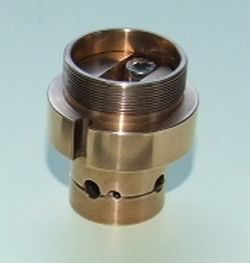
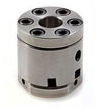
Nano-positioning stages from attocube
Nano-positioning stages can be installed on the ST-500 microscope cryostats for a number of short working distance applications. Because this design uses a standard ST-500 cryostat as a base, existing cryostats may be upgraded to the special
attocube configuration. These photos show an ST-500-attocube with a special flange-mounted on the bottom that will interface with an optical table. From the outside, this special ST-500-attocube looks identical to the model ST-500-LGV
microscopy cryostat, which has a 2.5 in cold plate and 7 in outer diameter vacuum chamber. Contact us for more information.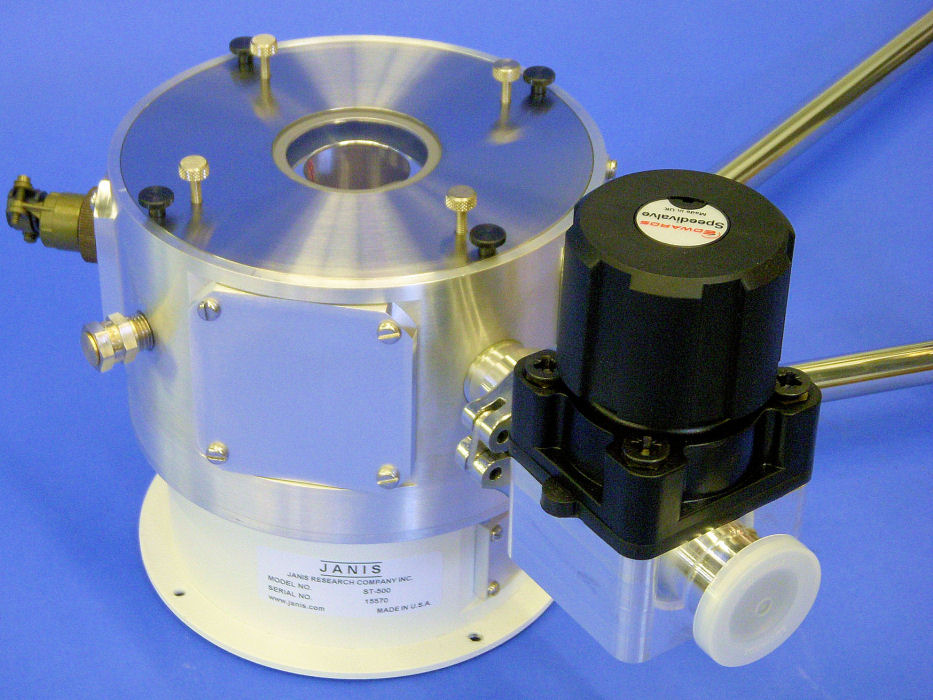

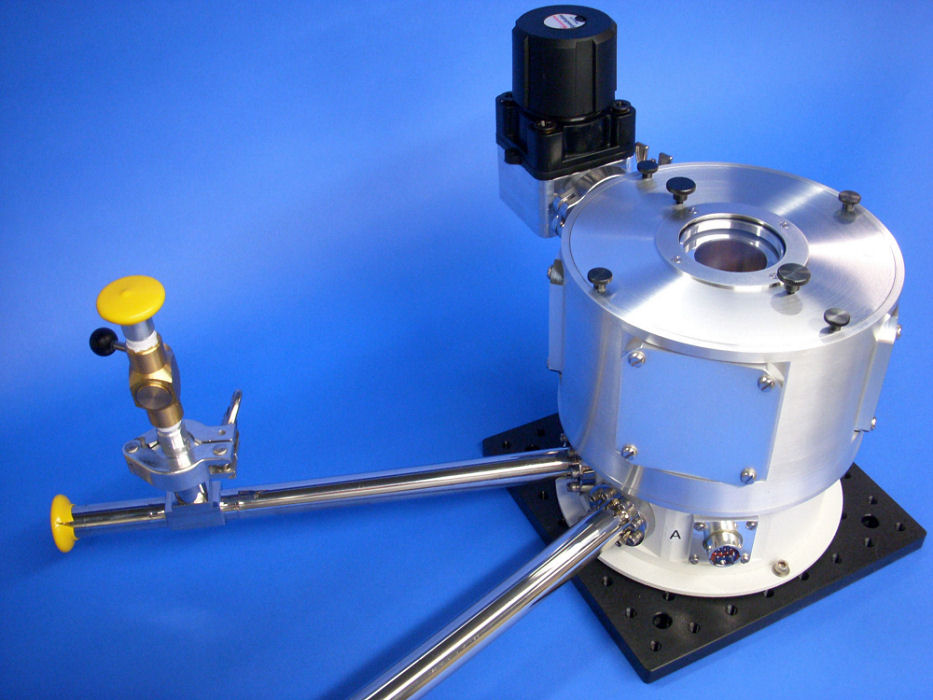
Sample extension for magnetic measurements
Using the same proven cryostat design as the regular ST-500 cryostat, the ST-500 for magnetic measurements features an extended sample mount for use inside the bore of a magnet. This extended sample mount may be purchased separately or with
a set of permanent magnets for measurements in fields of up to 0.5 T.
These photos show the ST-500 with an extended sample mount and permanent magnet. The length of the extension may be specified at the time of order, and
the position of the magnet relative to the sample is fixed using a Teflon spacer. The magnetic field direction is perpendicular to the plane of the sample.
The flexible ST-500 design means that the cryostat may be ordered with
an extended sample holder and vacuum shroud for magnetic measurements, and a standard sample holder and vacuum shroud for other measurements. Switching between the two holders is as simple as changing samples.
A set consists
of up to five interchangeable magnets: the full set allows measurements in discrete steps of 0.1 T. Existing ST-500 cryostats may be upgraded by simply ordering the special sample holder, vacuum shroud top plate, and radiation shield
cover.
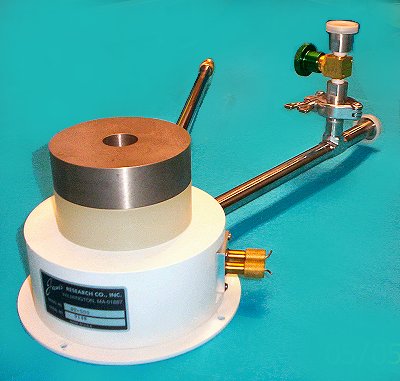
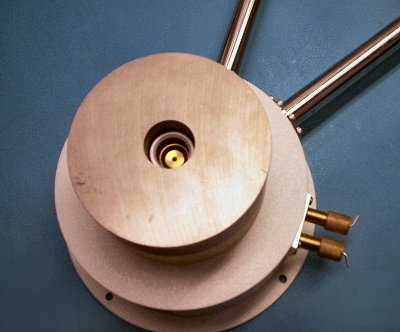
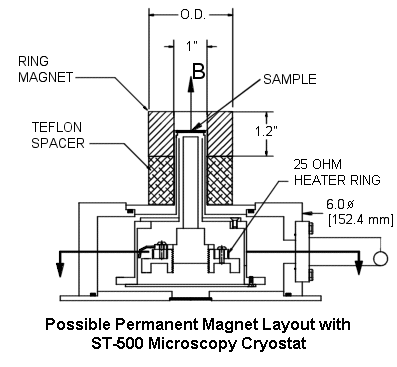
O-ring sealed top and bottom windows
For customers who require soft windows that cannot be epoxy sealed, we offer the option of using an o-ring seal to install the windows. The lower window is recessed so that it is flush with the bottom surface of the cryostat. The photo shows
a cryostat with an o-ring sealed top and bottom windows. This cryostat also featured a breakout box.
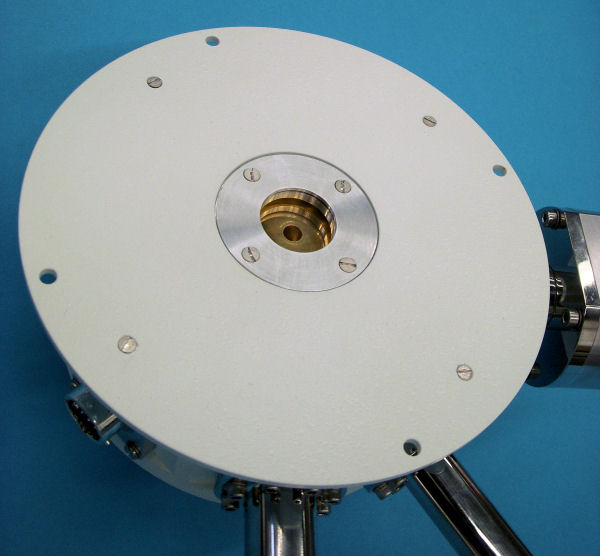
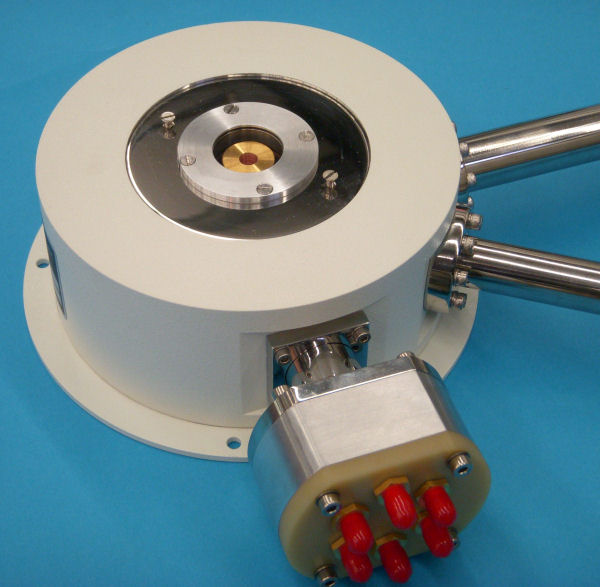
ST-500 with two special sample holders and black anodized aluminum baseplate
The ST-500 shown has two special sample holders (DIP socket and special customer-design) and a black anodized aluminum baseplate. The baseplate was designed to customer specifications so they can mount the ST-500 in their own setup. The ST-500
will be operated vertically. This baseplate design requires an adaptor flange. When the baseplate has clearance holes, instead of tapped holes, the customer can mount their ST-500 directly to the optical bench without providing any special
hardware on their own.

Ultra-high vacuum configurations
ST-500-UHV cryostat for microscopy with a UHV sample environment. This cryostat combines the already proven ultra-low vibration and thermal drift of the standard ST-500 microscope cryostat with UHV-compatible design features. This continuous flow cryostat includes the same heat exchanger design as the standard ST-500 resulting in a low thermal drift of ~2 nm/minute. It also has the same low base temperature (3.8 K) and helium consumption (~1.1 L/h)
as the standard ST-500.
Fully bakeable to 175 °C (~450 K), this cryostat is true-UHV and is equipped with a viewport configured for short working distance measurements. Different window materials are available to suit the required transmission range. Depending on the window thickness, the working distance can be as short as 1 mm. Like the standard ST-500, this versatile design can be modified to accept internal nano-positioning stages for x-y-z motion. Systems incorporating nanopositioning stages utilize flexible UHV copper thermal braids for sample cooling. The cryostat can also be configured for reflection or transmission measurements and includes electrical feedthroughs allowing a range of electrical measurements to be performed. The ST-500-UHV can be used with liquid helium or liquid nitrogen and will operate in any orientation. Janis can supply a complete turn-key package, including a temperature controller and pumping station. Contact us today to see how the ST-500-UHV can be tailored to meet your specific experimental needs.

Superconducting magnet for high-resolution microscopy
Designed to operate with a Janis high stability microscopy cryostat, this system allows microscopy measurements to be performed in fields of up to 6 T. The system comes with x-y-z translation stages for sample scanning and focusing, and
is designed for magneto-optical imaging at helium temperatures.
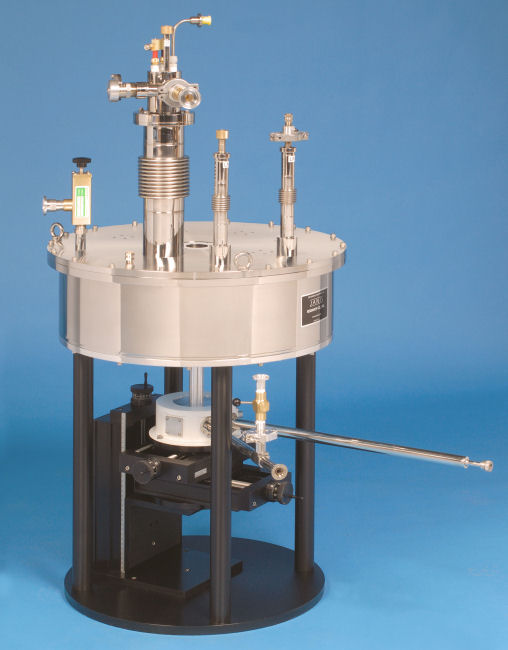
Micromanipulated cryogenic and vacuum probe systems for chips, wafers, and device testing
The Janis ST-500 series probe stations are high-performance research instruments designed to provide affordable vacuum and cryogenic probing of wafers and devices. The proven ST-500 cryostat is the platform for these probe stations and includes low vibration technology (originally designed for high spatial resolution optical microscopy) to provide outstanding sample positional stability. Researchers around the world are using these systems to conduct research in a wide variety of fields, including MEMS, nanoscale electronics, superconductivity, ferroelectrics, material sciences, and optics.


